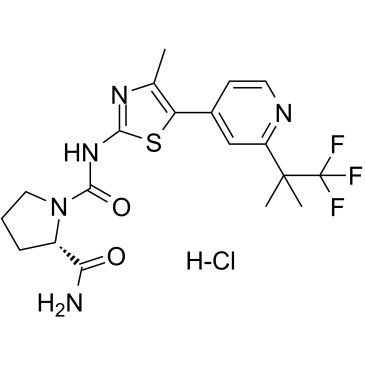Alpelisib hydrochloride
Modify Date: 2024-01-10 20:37:50

Alpelisib hydrochloride structure
|
Common Name | Alpelisib hydrochloride | ||
|---|---|---|---|---|
| CAS Number | 1584128-91-5 | Molecular Weight | 477.93 | |
| Density | N/A | Boiling Point | N/A | |
| Molecular Formula | C19H23ClF3N5O2S | Melting Point | N/A | |
| MSDS | N/A | Flash Point | N/A | |
Use of Alpelisib hydrochlorideAlpelisib hydrochloride (BYL-719 hydrochloride) is a potent and selective PI3Kα inhibitor with IC50s of 5 nM, 250 nM, 290 nM and 1200 nM for p110α, p110γ, p110δ, and p110β, respectively[1]. |
| Name | Alpelisib hydrochloride |
|---|
| Description | Alpelisib hydrochloride (BYL-719 hydrochloride) is a potent and selective PI3Kα inhibitor with IC50s of 5 nM, 250 nM, 290 nM and 1200 nM for p110α, p110γ, p110δ, and p110β, respectively[1]. |
|---|---|
| Related Catalog | |
| In Vitro | Alpelisib (BYL-719) potently inhibits the 2 most common PIK3CA somatic mutations (H1047R, E545K; IC50s~4 nM). Alpelisib potently inhibits Akt phosphorylation in cells transformed with PI3Kα (IC50=74±15 nM) and shows significant reduced inhibitory activity in PI3Kβ or PI3Kδ isoforms transformed cells (≥15-fold compared with PI3Kα)[2]. Alpelisib (BYL-719, 0-50 μM; 72 hours) inhibits the cell growth of osteosarcoma cell lines MG63, HOS, POS-1 and MOS-J in a dose-dependent manner[3]. Alpelisib (BYL-719) significantly alters the distribution of cell cycle phases. Alpelisib (BYL-719, 25 μM; 18 hours) induces a cell cycle arrest in the G0/G1 phase of human and murine osteosarcoma cell lines[3]. Cell Proliferation Assay[3] Cell Line: MG63, HOS, POS-1, MOS-J Concentration: 10, 20, 30, 40, 50 μM Incubation Time: 72 hours Result: Inhibited the cell growth of all osteosarcoma cell lines tested in a dose-dependent manner with IC50s of 6-15 µM and with IC90s of 24-42 µM. Cell Cycle Analysis[3] Cell Line: MG63, HOS, POS-1, MOS-J Concentration: 25 μM Incubation Time: 18 hours Result: Induced a cell cycle arrest in the G0/G1 phase of human and murine osteosarcoma cell. |
| In Vivo | Alpelisib (BYL-719) (12.5 mg/kg and 50 mg/kg for C57Bl/6J mice; 50 mg/kg for female Rj:NMRI-nude mice; oral administration; daily) significantly reduces tumor volumes and deposition of ectopic bone matrix[3]. Alpelisib has moderate terminal elimination half-life (t1/2=2.9±0.2 h) for rat (1 mg/kg, iv)[1]. Animal Model: A 5-week-old female Rj:NMRI-nude mice with human HOS-MNNG osteosarcoma cells; A 5-week-old male C57Bl/6J mice with mouse MOS-J osteosarcoma cells[3] Dosage: 12.5 mg/kg and 50 mg/kg for C57Bl/6J mice; 50 mg/kg for female Rj:NMRI-nude mice Administration: Oral administration; daily Result: Significantly reduced tumor volumes and simultaneously reduced tumor growth. Animal Model: Female Sprague Dawley rats [1] Dosage: 1 mg/kg (Pharmacokinetic Study) Administration: I.V. Result: T1/2=2.9±0.2 hours. |
| References |
| Molecular Formula | C19H23ClF3N5O2S |
|---|---|
| Molecular Weight | 477.93 |